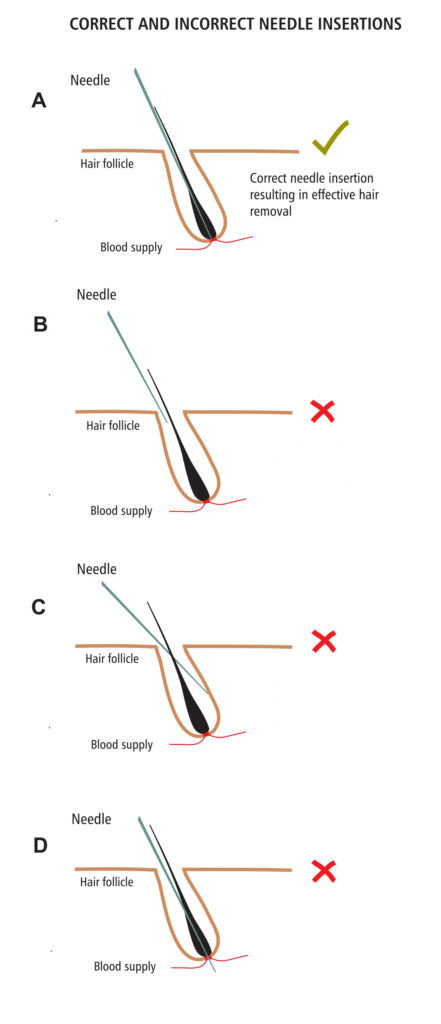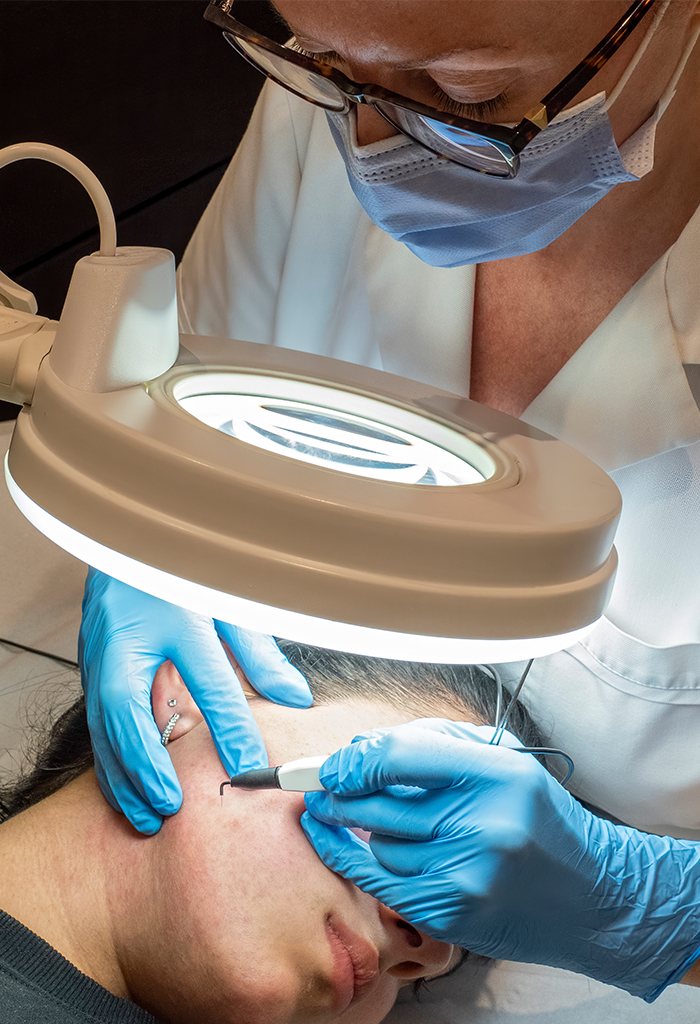What is electrolysis?
Electrolysis is a method of permanent hair removal.
How electrolysis works

Rachel’s advice:
Electrolysis does not work magically on its own. Electrolysis is only as good as the person performing it. The insertion of the probe should not be painful as it should be following the exact direction of the follicle under the skin (imagine a little tunnel). Heat is then applied to dry up the lower part of the follicle then the hair is lifted out. The client should not feel the hairs being pulled in any way as they are being removed. If you do then the likelihood is the treatment will not be successful.
What causes hair growth?
Two things cause hair growth – hormones and stimulation of the blood supply. This is why other methods of hair removal, such as waxing, shaving, tweezing and threading, simply don’t work in the long term as they all stimulate the growth of thicker, stronger hair.
Who is it suitable for?
It is suitable for all skin and hair types, even if the area has been subjected to years of shaving, plucking or waxing. However, you cannot have electrolysis if you have a pacemaker or during the first 12 weeks of pregnancy. Some other conditions may require GP consent.
How does it work?
Electrolysis uses a very fine sterile disposable needle that is inserted into the natural opening in the skin where the hair grows from (the follicle). Heat is applied via the needle to micro cauterise the blood supply and destroy the hair growth cells. The probe is then removed and a pair of tweezers is used to lift the hair out of the skin.
What areas is it suitable for?
Electrolysis can be performed on any part of the face and body, including eyebrows and nipples.
How often will I need treatment?
Depending on the area and sensitivity of the skin, most clients have weekly sessions until the treatment is finished.
How will it feel?
Everyone is different. A mild burning sensation is experienced, which most people find completely bearable. If required, more sensitive clients can apply a topical anaesthetic cream before treatment.
How long does each session take?
This all depends on the area to be treated. An upper lip, for example, would normally be a 15-20 minute session. The bikini line would be a 45-60 minute session. How many sessions depends on the amount of hairs and size of area to be treated.
How long will it be before I see results?
Each hair is treated individually and most hairs require two to three treatments to stop growth completely. The process is repeated over the area until all unwanted hairs are removed permanently. You should see a reduction in hairs after a few treatments. For permanent results, the course must be completed over the cycle of hair growth.
What will I experience after treatment?
Most people will have a mild redness on the skin, which normally lasts 20 to 30 minutes. A little swelling may also occur and some people may see a few spots. All are temporary reactions.
Are there any side effects?
Electrolysis is a very safe treatment and has been used for over 100 years. However, successful treatment requires great skill and expertise. A good therapist is vital to satisfactory results.
I have had electrolysis elsewhere in the past but it didn’t work. Why?
There are many reasons, but the most likely is that it was not performed properly. Did you feel as though the hairs were being plucked or pulled out? When performed correctly, the hair slides out without any resistance, so you shouldn’t feel it being removed. Other reasons you may not have had a good result include plucking/waxing hair between treatments and not having the recommended amount of sessions. A skilled therapist should be able to talk you through exactly how the treatment works and what is required for permanent results.
What about aftercare?
Skin should be kept clean and dry for 24 hours after treatment. No sun exposure and/or heat treatments, such as steam, sauna, hot yoga. Make-up should also be avoided. Antiseptic cream to heal and soothe is recommended for two days after treatment. In between sessions it is vital that you do not pluck, shave, tweeze or wax hairs. Cutting/trimming the hair is advised instead.
Please see our aftercare information below:
- Advise the client not to touch the area treated with their hands. Risk of infection from bacteria on hands.
- Keep the area cool, clean and dry.
- Do not use sun-beds or have direct sun exposure on the area throughout the treatment process. Sun protection SPF30 must be worn everyday to prevent hyperpigmentation (especially in Fitzpatrick skin tones 3, 4, 5 & 6).
- Do not apply any makeup on the area for 24 hours.
- Do not apply deodorant to under arms – if they have been treated.
- Do not have any heat treatment for 24 hours. This included the use of saunas, steam rooms, hot yoga (Bikram), hot baths or showers.
- Do not participate in any cardiovascular exercise for 24 hours.
- Apple aloe vera to the area for 2 days after treatment.
Immediately post treatment care:
- The skin may look inflamed and red (erythema). This is a normal reaction to a heat treatment.
- If the client has time, ask them to sit with a cold compress or ice-pack (wrapped in a clean gauze to prevent ice burn) for 10 minutes. This helps to reduce inflammation immediately, reducing skin side effects. If the client does not have time, suggest that they buy a cold bottle of water to place on the area for 10 minutes. Give them a gauze to wrap around it, so that it is hygienic.
The evening of treatment:
- Tell the client to wash their hands and then wash their face with a gentle cleanser and apply aloe vera or witch hazel gel.
- Avoid rich, greasy products.
- Do not apply any acid or enzyme based products (this includes, but not exclusive to, the use of any retinoids/retinol/retinal/retinoate, glycolic, salicylic and mandelic acids).
- We recommend using Hypo21 healing spray immediately after and daily to repair their skin and reduce chances of any breakouts following treatment.

